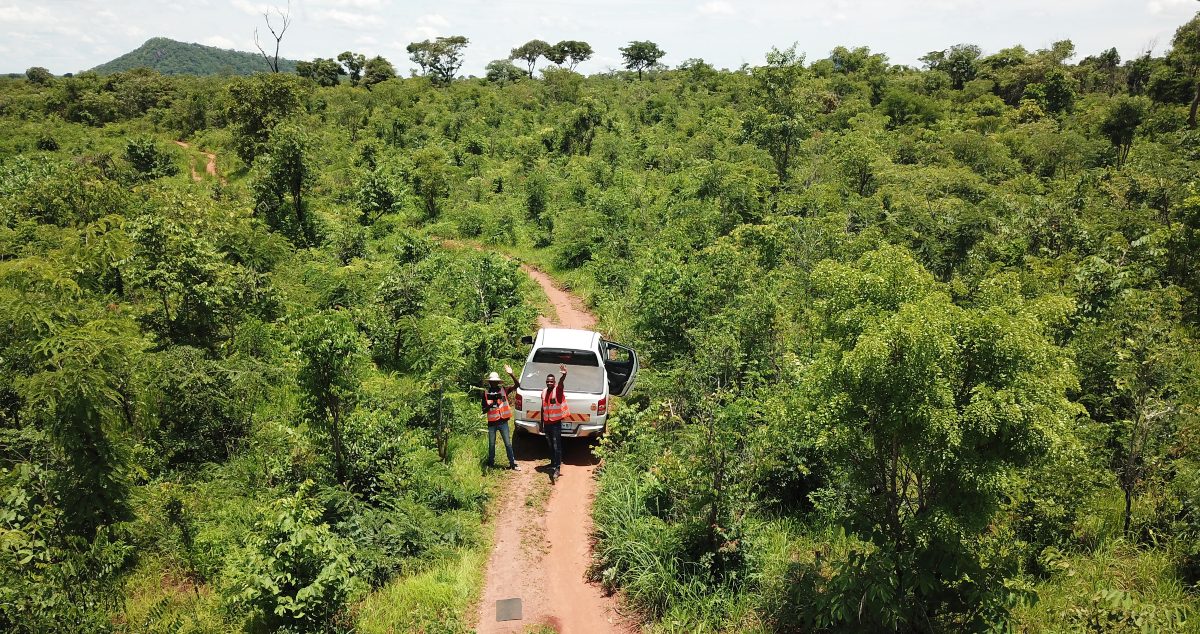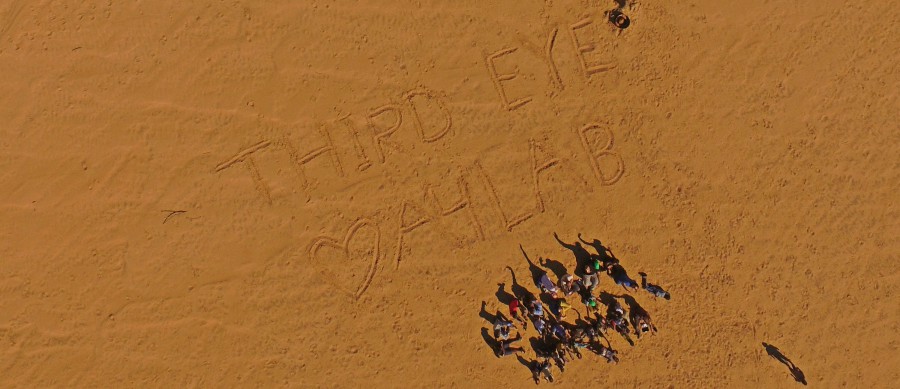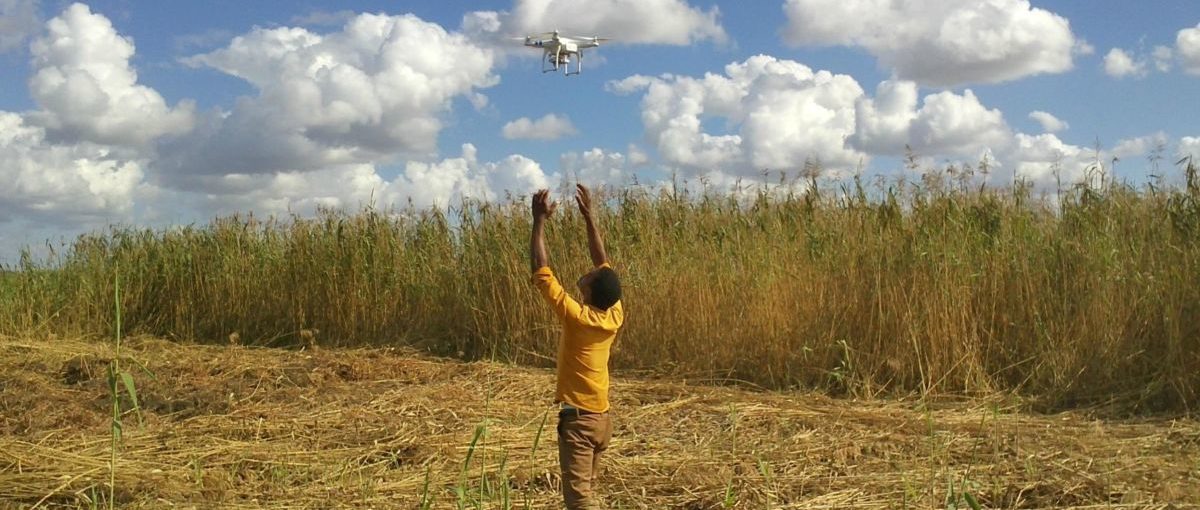A key factor in enabling an increase and efficiency in food production is providing farmers with relevant information. Such information is needed as farmers have limited resources (seed, water, fertilizer, pesticides, human power) and are always in doubt in which location and when they should supply these resources. Interesting is that especially smallholders, with their limited resources, are in need of this kind of information. Spatial information from flying sensors (drones) can be used for this. Flying sensors offer also the opportunity to obtain information outside the visible range and can therefore detect information hidden for the human eye (Third Eye). Nowadays, low-cost sensors in the infra-red spectrum can detect crop stress about two weeks before the human eye can see this.
The ThirdEye project supports farmers in Mozambique and Kenya by setting up a network of flying sensors operators. These operators are equipped with flying sensors and tools to analyse the obtained imagery. Our innovation is a major transformation in farmers’ decision making regarding the application of limited resources such as water, seeds, fertilizer and labor. Instead of relying on common-sense management, farmers are now able to take decisions based on facts, resulting in an increase in water productivity. The flying sensor information helps farmers to see when and where they should apply their limited resources. We are convinced that this innovation is a real game-changing comparable with the introduction of mobile phones that empowered farmers with instantaneous information regarding markets and market prices. With information from flying sensors they can also manage their inputs to maximize yields, and simultaneously reduce unnecessary waste of resources. In summary, the missing information on markets has been solved by the mobile phone introduction, the flying sensors close the missing link to agronomic information on where to do what and when.
Latest News
FutureWater and HiView give lectures on the use of flying sensors
Last week FutureWater, together with its partner HiView, gave 2 days of lectures at IHE Delft Institute for Water Education, which partners with UNESCO. As part of their master degree, around 25 students were taught on the theory behind flying sensors (also known as drones), the different types of applications and how to use them […]
Seminar on the use of flying sensors in agriculture held in Kenya
In a bid to create and increase more awareness on the use of flying sensors (drones) in agriculture, FutureWater and HiView, held a seminar on March 2, 2018 at the KALRO (Kenya Agricultural & Livestock Research Organization) Headquarters in Nairobi, Kenya. The seminar was attended by KALRO researchers, representatives of SNV, government employees, as well […]
ThirdEye makes drone technology accessible for African farmers
In the Netherlands, drones already play an important role in agriculture: from the air they can monitor the growth of crops very precisely. Here high-quality sensors and relatively expensive drones are used. Thanks to these sensors and special software the needs of the crops (e.g. water, fertilizer or plant protection products) can be calculated. “A […]
First ThirdEye flying sensor operators trained in Kenya
The ThirdEye project supports farmers in Kenya by setting up a network of flying sensors operators. These operators are equipped with flying sensors and tools to analyse the obtained imagery. In December ThirdEye staff conducted an intensive two weeks flying sensor training at Agricultural Training Centre (ATC) Kaguru, 15 km south of Meru, Kenya. The […]
Study conducted on water productivity mapping using flying sensors and crop modeling
Recently, FutureWater conducted a study for RVO to test the feasibility of mapping water productivity and yield gaps based on a combination of Flying Sensor imagery and crop water productivity modeling in order to provide plot-level recommendations to farmers. The objective of this pilot study was to achieve plot-level maps of water productivity and yield […]
FutureWater releases new study on monitoring Water Productivity
Water Productivity, expressed as the amount of crop yield over the amount of water consumed (kg/m3), has been accepted as the standard to monitor sustainable water management. FutureWater has evaluated various methods, including satellites and Flying Sensors (drones) to monitor Water Productivity for a demonstration project ThirdEye in southern Mozambique. Monitoring Water Productivity is set […]
MSc thesis research on efficient use of water in agriculture: visiting Xai-Xai, Mozambique
Increasing world population, rising food demand, limited water resources. Currently 70% of the fresh water uptakes are already used for irrigation. The need for efficient water use in agriculture is undisputed! The United Nations’ Sustainable Development Goal 6.4 is set at the improvement of efficient use in order to reduce water scarcity and maintain food […]
Field visit on monitoring water productivity in Quelimane, Mozambique
To follow up a good practical example of a our Masterclass on Water Productivity, our colleague Nadja den Besten went on a mission to Quelimane in Mozambique. FutureWater was invited to assess project APROVALE, Água Produtiva no Vale do Zambeze, in the Zambezi Valley. The project is led by Agencia de Desenvolvimento do Vale do Zambeze (ADVZ), […]
A4Lab deploys FutureWater’s drone technique to explore water potential of dry river beds in Mozambique
Text adopted from Dutchwatersector.com Research group A4Lab deployed a drone of FutureWater’s Mozambican ThirdEye project, to assess the water availability in the dry river beds of the Limpopo river, near the city of Chókwè in Moazambique. The exploration is to deliver more data on the amounts of water in the sandy river beds throughout the dry […]
ThirdEye featured in USAID Water Report
SWFF Innovators FutureWater was featured in USAID’s recently published Safeguarding the World’s Water: Report of Water Sector Activities, which details the Agency’s investments and efforts in WASH and nutrition, agricultural water management, sustainability of WASH services; sanitation; and water quality. This report describes a wide range of programs consistent with USAID’s Water and Development strategy’s focus on maintaining […]











